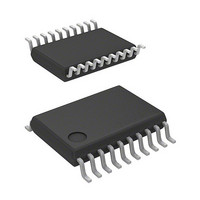R5F21324CNSP#U0 Renesas Electronics America, R5F21324CNSP#U0 Datasheet - Page 130

R5F21324CNSP#U0
Manufacturer Part Number
R5F21324CNSP#U0
Description
MCU 1KB FLASH 16K ROM 20-LSSOP
Manufacturer
Renesas Electronics America
Series
R8C/3x/32Cr
Datasheet
1.R5F21321CDSPU0.pdf
(605 pages)
Specifications of R5F21324CNSP#U0
Core Processor
R8C
Core Size
16/32-Bit
Speed
20MHz
Connectivity
I²C, LIN, SIO, SSU, UART/USART
Peripherals
POR, PWM, Voltage Detect, WDT
Number Of I /o
15
Program Memory Size
16KB (16K x 8)
Program Memory Type
FLASH
Ram Size
1.5K x 8
Voltage - Supply (vcc/vdd)
1.8 V ~ 5.5 V
Data Converters
A/D 4x10b
Oscillator Type
Internal
Operating Temperature
-20°C ~ 85°C
Package / Case
20-LSSOP
Lead Free Status / RoHS Status
Lead free / RoHS Compliant
Eeprom Size
-
- Current page: 130 of 605
- Download datasheet (6Mb)
R8C/32C Group
REJ09B0573-0100 Rev.1.00 Dec. 18, 2009
Page 101 of 573
The clocks generated by the clock generation circuits are described below.
9.3
Figure 9.4
The XIN clock is supplied by the XIN clock oscillation circuit. This clock is used as the clock source for the CPU
and peripheral function clocks. The XIN clock oscillation circuit is configured by connecting a resonator between
pins XIN and XOUT. The XIN clock oscillation circuit includes an on-chip feedback resistor, which is
disconnected from the oscillation circuit in stop mode in order to reduce the amount of power consumed by the
chip. The XIN clock oscillation circuit may also be configured by feeding an externally generated clock to the
XOUT pin.
Figure 9.4 shows Examples of XIN Clock Connection Circuit.
During and after a reset, the XIN clock stops.
After setting the CM13 bit in the CM1 register to 1 (XIN-XOUT pin), the XIN clock starts oscillating when the
CM05 bit in the CM0 register is set to 0 (XIN clock oscillates). After the XIN clock oscillation stabilizes, the XIN
clock is used as the CPU clock source when the OCD2 bit in the OCD register is set to 0 (XIN clock selected).
The power consumption can be reduced by setting the CM05 bit in the CM0 register to 1 (XIN clock stops) if the
OCD2 bit is set to 1 (on-chip oscillator clock selected).
When an externally generated clock is input to the XOUT pin, the XIN clock does not stop even if the CM05 bit is
set to 1. If necessary, use an external circuit to stop the clock.
In stop mode, all clocks including the XIN clock stop. Refer to 9.7 Power Control for details.
XIN Clock
• When CM05 bit in CM0 register
Notes:
Ceramic resonator external circuit
is set to 0 (XIN clock oscillates)
and CM13 bit in CM1 register is
set to 1 (XIN-XOUT pin)
1. Insert a damping resistor if required. The resistance will vary depending on the oscillator and
2. Insert a damping resistor if required to prevent an overshoot from occurring.
(on-chip feedback resistor)
XIN
the oscillation drive capacity settings. Use the values recommended by the oscillator manufacturer.
If the oscillator manufacturer's datasheet specifies that a feedback resistor be added to the chip
externally, insert a feedback resistor between XIN and XOUT following the instructions.
Examples of XIN Clock Connection Circuit
CIN
MCU
Rf
(1)
XOUT
Rd
COUT
(1)
• When CM05 bit in CM0 register
VCC
VSS
is set to 1 (XIN clock stops),
CM11 bit in CM1 register is set
to 1 (internal feedback resistor
disabled), and the CM13 bit is
set to 1 (XIN-XOUT pin)
External clock input circuit
(on-chip feedback resistor)
Open
XIN
Externally generated clock
MCU
9. Clock Generation Circuit
XOUT
(2)
Related parts for R5F21324CNSP#U0
Image
Part Number
Description
Manufacturer
Datasheet
Request
R

Part Number:
Description:
KIT STARTER FOR M16C/29
Manufacturer:
Renesas Electronics America
Datasheet:

Part Number:
Description:
KIT STARTER FOR R8C/2D
Manufacturer:
Renesas Electronics America
Datasheet:

Part Number:
Description:
R0K33062P STARTER KIT
Manufacturer:
Renesas Electronics America
Datasheet:

Part Number:
Description:
KIT STARTER FOR R8C/23 E8A
Manufacturer:
Renesas Electronics America
Datasheet:

Part Number:
Description:
KIT STARTER FOR R8C/25
Manufacturer:
Renesas Electronics America
Datasheet:

Part Number:
Description:
KIT STARTER H8S2456 SHARPE DSPLY
Manufacturer:
Renesas Electronics America
Datasheet:

Part Number:
Description:
KIT STARTER FOR R8C38C
Manufacturer:
Renesas Electronics America
Datasheet:

Part Number:
Description:
KIT STARTER FOR R8C35C
Manufacturer:
Renesas Electronics America
Datasheet:

Part Number:
Description:
KIT STARTER FOR R8CL3AC+LCD APPS
Manufacturer:
Renesas Electronics America
Datasheet:

Part Number:
Description:
KIT STARTER FOR RX610
Manufacturer:
Renesas Electronics America
Datasheet:

Part Number:
Description:
KIT STARTER FOR R32C/118
Manufacturer:
Renesas Electronics America
Datasheet:

Part Number:
Description:
KIT DEV RSK-R8C/26-29
Manufacturer:
Renesas Electronics America
Datasheet:

Part Number:
Description:
KIT STARTER FOR SH7124
Manufacturer:
Renesas Electronics America
Datasheet:

Part Number:
Description:
KIT STARTER FOR H8SX/1622
Manufacturer:
Renesas Electronics America
Datasheet:

Part Number:
Description:
KIT DEV FOR SH7203
Manufacturer:
Renesas Electronics America
Datasheet:










